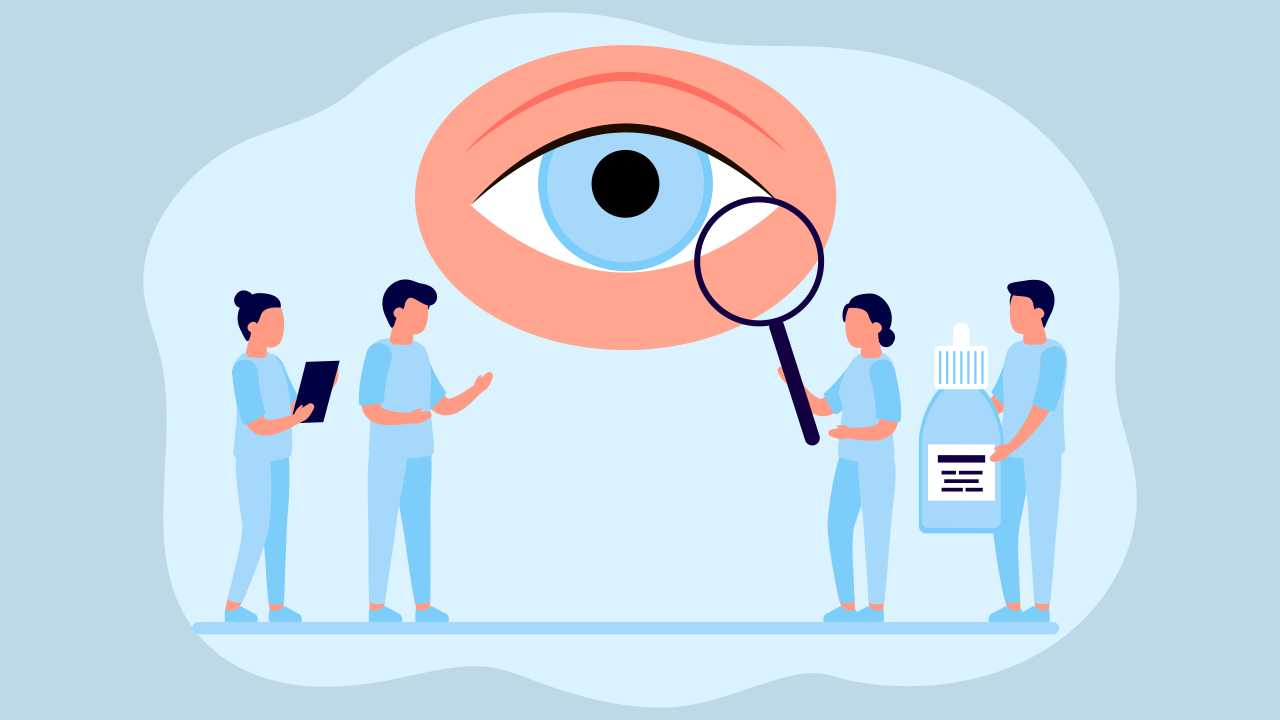
Glaucoma: Symptoms, Causes, and Management

It is estimated that by the year 2040, about 111.8 million people worldwide will suffer from glaucoma, an eye-related disorder that can lead to irreversible blindness. That said, early diagnosis and intervention can prevent vision loss. But it’s easier said than done as individuals with glaucoma may remain asymptomatic and the disorder undetected. It is estimated that only about 10%–50% of individuals with glaucoma are aware of their condition.
What is glaucoma?
Glaucoma is a group of eye conditions, where the optic nerve, the nerve connecting the eye to the brain, gets damaged leading to loss of vision.
This damage to the nerve happens over a period of time. The main reason for this damage is the accumulation of aqueous humor, a clear fluid inside the closed chamber of the eye. Aqueous humor is present in the front chambers of your eyes, and also does the crucial job of nourishing it. It also maintains its round shape by balancing the pressures inside the chambers of the eye.
There is continuous production of small amounts of aqueous humor in the eye. The fluid keeps flowing inside the eye and gets reabsorbed into the blood through an intricate system of minute canals in the eye. Ideally, the amount of aqueous humor that drains out should be replaced by the newly produced fluid, which stabilizes the pressure within the eye, known as the intraocular pressure (IOP).
However, if the drainage system is not efficient, there is fluid buildup. This leads to increased IOP. If not checked, elevated IOP can damage the optic nerve over a period of time.
Damage to the optic nerve causes the nerve fibers to die, leading to vision problems such as blind spots. Although not quite noticeable initially, as the damage progresses, the death of all nerve fibers will result in complete blindness.
Types of glaucoma
Broadly, glaucoma can be classified into:
- Open-angle glaucoma
- Angle-closure glaucoma
- Normal-tension glaucoma
Irrespective of the type of glaucoma, the symptoms are more or less the same, so you need to keep a watch as glaucoma is a “silent killer of vision”. Elderly people using high-powered glasses and people with health conditions like diabetes and hypertension must be extra vigilant, as they are at higher risk of developing glaucoma.
Glaucoma symptoms
In early stages, glaucoma is mostly painless and does not show any symptoms. Blurring or loss of side vision happens later. A lot of the time, symptoms are so subtle that only a detailed examination of the eye by an ophthalmologist can reveal the condition. Gradually, the symptoms progress to more prominent vision loss and total blindness.
In a few cases, the patient may get an acute glaucoma attack, where the pressure inside the eye rises suddenly, leading to severe pain and sudden vision loss.
Consult an ophthalmologist at the earliest if you observe the following symptoms of glaucoma:
- Blurred or diminished vision
- Seeing halos/ rainbows
- Eye pain, pain in the forehead, or headache
- Redness of the eye
- Nausea and vomiting
Glaucoma risk factors
Although anyone can develop glaucoma, certain factors increase the risk such as:
- If you are over 40 years
- Family history of glaucoma
- Increased IOP due to any reason
- Eye injury
- Thinning of optic nerve due to some other disease
- Nearsightedness
- Farsightedness
- Prolonged use of certain steroids
- Other health conditions like diabetes, hypertension, migraine
Screening
There is no clear consensus on the age and number of times one should get screened for glaucoma. Some recommend annual screening for those above 45 years of age, and more frequently, for those with risk factors for glaucoma.
Tonometry and goniometry are the two tests done for glaucoma screening. Before the test, the doctor may ask you to use a few eye drops. This can cause slight discomfort for a few seconds.
Usually, the screening involves checking eye pressure, drainage angle of the eye, peripheral vision, corneal thickness, and examining the optic nerve.
Also Read: Medical Screening Tests for Men and Women: A Checklist
Management
There is no permanent cure for glaucoma. Therefore, diagnosis and treatment of glaucoma are important to check its progression as damage caused by this condition is irreversible. However, timely intervention can help prevent further damage. Depending on the stage, the recommended glaucoma treatments include:
1. Medications
Using medications in the form of eye drops as per your ophthalmologist’s instructions can help in lowering the high eye pressure. These medications can help in reducing the production of aqueous humor, and also allow better drainage of fluid from the eye. However, the medications can have side-effects, and therefore should only be taken if prescribed by an ophthalmologist.
2. Surgery
Surgery can help in better drainage of aqueous humor, especially in babies born with glaucoma. However, surgery does not cure glaucoma and symptoms begin to reappear later.
3. Implant
If eye drops and surgeries do not sufficiently lower the eye pressure, a glaucoma drainage implant may be recommended. Glaucoma drainage implant is a small device placed in the eye to help in better drainage of the aqueous liquid.
Glaucoma prevention
Vision problems associated with glaucoma may not be noticeable till the condition progresses and symptoms become severe. However, timely intervention can help in preventing or slowing the damage.
1. Regular eye exams
One of the effective steps in the early diagnosis of glaucoma is to go for regular eye exams. These checkups are especially important for those having risk factors. Consult your ophthalmologist for the ideal frequency of check-ups.
2. Medications
Long-term use or taking high doses of certain steroids, especially oral use or topical application around the eyes, can cause elevated IOP. If you are on steroids, inform your ophthalmologist.
Very low blood pressure during sleep can worsen glaucoma-induced damage. You must inform your ophthalmologist if you take medications for hypertension, especially at night, or have frequent low blood pressure.
3. Preventing eye injuries
Eye injuries are a risk factor. You must always use eye-protection gear while performing activities that may pose a danger to your eyes.
Also Read: Eye Health: Tips for Maintaining Good Vision
4. Protection from sunlight
Sunlight may trigger glaucoma, hence use good quality sunglasses that offer UV protection and broad-brimmed hats if you tend to stay outdoors for longer periods.
5. Avoiding head-down positions
Head-down positions can cause higher pressure in your eyes. Therefore, individuals who have glaucoma or are at high risk of developing glaucoma, are advised to avoid head-down positions, where you position your head below the heart level for prolonged periods.
6. Sleeping position
People with glaucoma are advised to avoid sleeping with their eyes pressed against the pillow or their arms.
7. Exercise
High-intensity exercises increase your heart rate and can also increase your eye pressure. When doing such exercises, practice correct form and proper breathing technique. Other moderate-intensity workouts like walking can help in maintaining a steady eye pressure and benefit overall health.
Regular eye check-ups and early detection are a few ways on how to prevent glaucoma. Those who have a genetic predisposition to glaucoma, are suffering from a health condition that increases their chances of developing glaucoma, and the elderly must take extra precautions to protect their vision.
References
1. Weinreb RN, Aung T, Medeiros FA. The Pathophysiology and Treatment of Glaucoma. JAMA 2014; 311: 1901–11.
2. Boyd K. What Is Glaucoma? American Academy of Ophthalmology. https://www.aao.org/eye-health/diseases/what-is-glaucoma (accessed Apr 1, 2021).
3. Causes of Glaucoma. https://www.aao.org/eye-health/diseases/glaucoma-causes (accessed Apr 1, 2021).
4. Who Is at Risk for Glaucoma? https://www.aao.org/eye-health/diseases/glaucoma-risk (accessed Apr 1, 2021).
5. Glaucoma treatment. https://www.aao.org/eye-health/diseases/glaucoma-treatment (accessed Apr 1, 2021).
6. Boyd K. 10 Things To Do Today To Prevent Vision Loss From Glaucoma. American Academy of Ophthalmology. https://www.aao.org/eye-health/tips-prevention/easy-steps-to-prevent-vision-loss-from-glaucoma (accessed Apr 2, 2021).
7. Glaucoma. MayoClinic. https://www.mayoclinic.org/diseases-conditions/glaucoma/symptoms-causes/syc-20372839 (accessed Apr 2, 2021).














